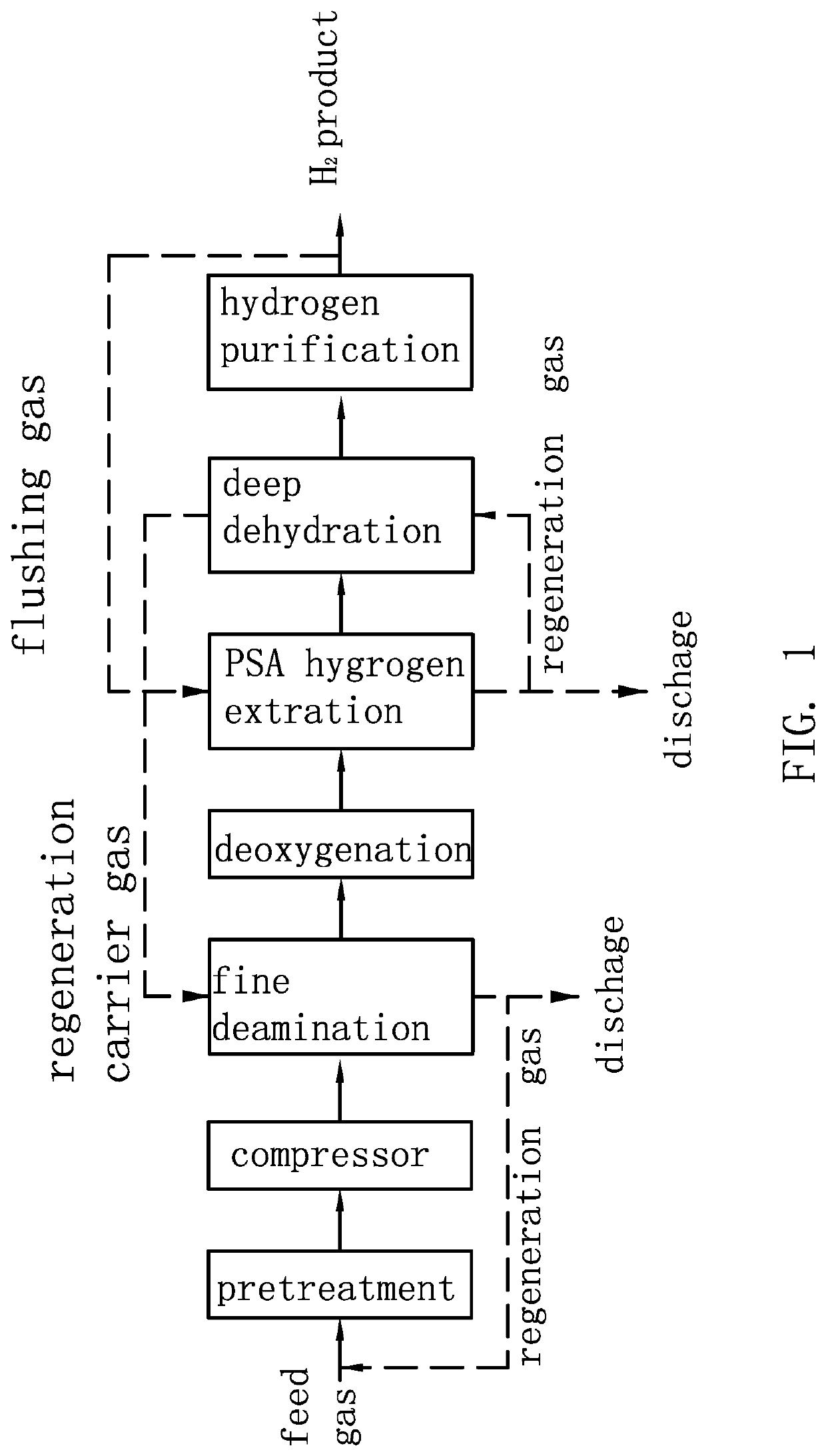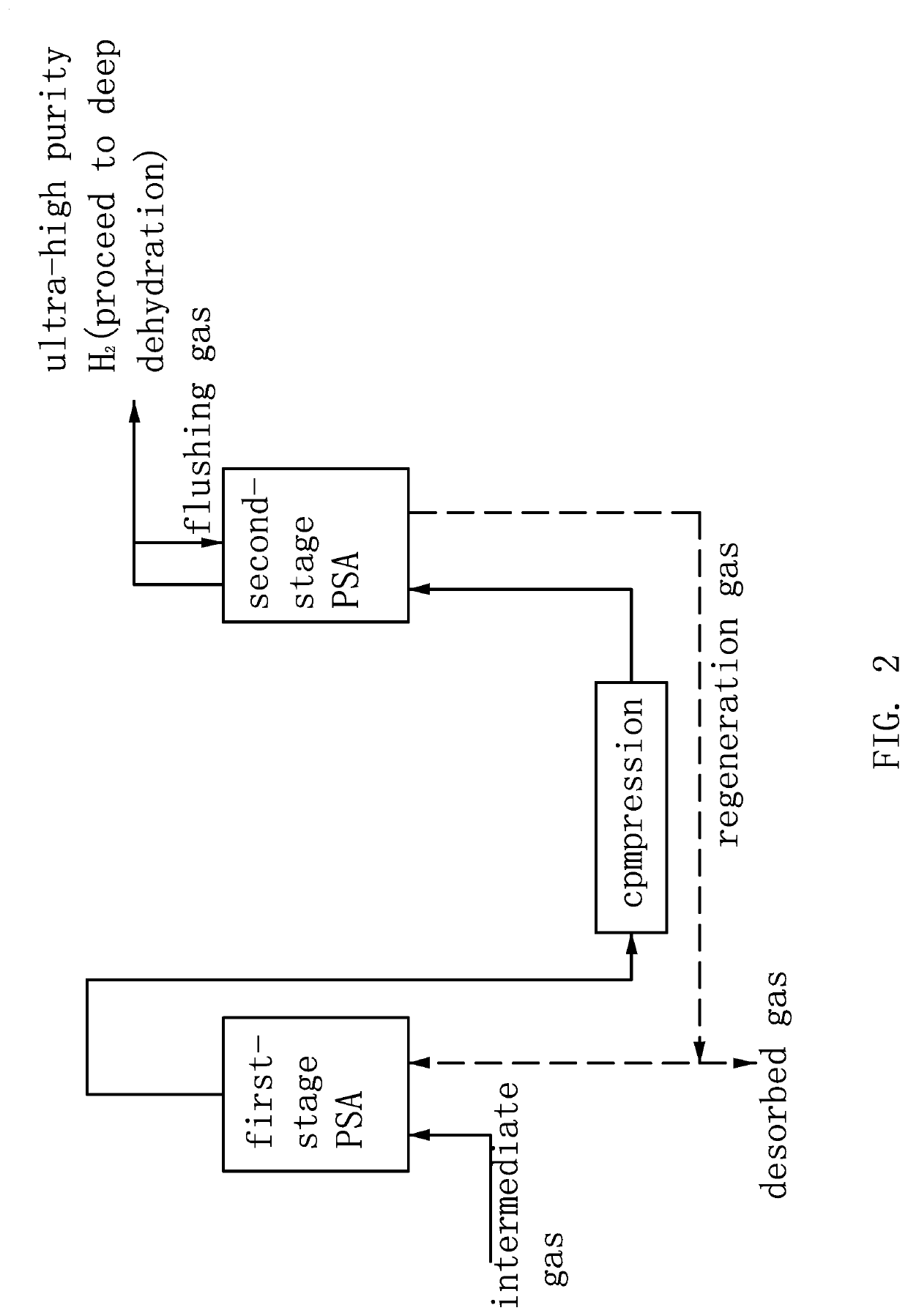Methods For Extracting And Recycling Hydrogen From MOCVD Process Exhaust Gas By FTrPSA
- Summary
- Abstract
- Description
- Claims
- Application Information
AI Technical Summary
Benefits of technology
Problems solved by technology
Method used
Image
Examples
embodiment 1
[0038]As shown in FIG. 1, a method for extracting and recycling hydrogen from an MOCVD process exhaust gas by full temperature range-pressure swing adsorption includes the following specific implementation steps:
[0039](1) a feed gas, i.e., an exhaust gas in a manufacturing process for an LED based on gallium nitride epitaxial wafer growth which is prepared by MOCVD at atmospheric pressure or low pressure, the feed gas mainly consisting of 46% (v / v, the same below) of nitrogen (N2), 34% of hydrogen (H2), and 19% of ammonia (NH3), and the remaining 1% being a small quantity of metal ions, particles, arsine, methane (CH4), water (H2O), carbon monoxide (CO), carbon dioxide (CO2), and oxygen (O2), and other impurity components, where the pressure is atmospheric pressure or low pressure, and the temperature is 30-50° C.;
[0040](2) pretreatment: introducing, by a blower, the feed gas into a pretreatment unit consisting of a feed gas buffer tank, a dust remover, a particle removing filter, a...
embodiment 2
[0046]As shown in FIG. 1, on the basis of embodiment 1, the feed gas from the pretreatment procedure is pressurized to 1.4-1.6 MPa, and then enters the fine deamination procedure for fine deamination; the formed intermediate gas exchanges heat with the fluid at the outlet in the tail end of the compressor to reach 70-90° C., and then enters the de-oxygenation procedure for de-oxygenation; the deoxygenated intermediate gas is cooled to 30-50° C. by heat exchange, and enters the PSA hydrogen extraction procedure for hydrogen purification. In the hydrogen purification procedure, there is no need to adjust the pressure by the reducing valve, and the pressure of the entire system is kept at 1.4-1.6 MPa. The system is relatively stable and the yield of the electronic-level hydrogen product is greater than 75-86%.
embodiment 3
[0047]As shown in FIG. 1, on the basis of embodiment 1, when the temperature of the feed gas is 100-120° C., the feed gas is pressurized to 3.5-4.0 MPa and cooled to 70-90° C. after exchanging heat with the ultra-high purity hydrogen, and enters the fine deamination, de-oxygenation, PSA hydrogen extraction, and hydrogen purification procedures, where the deoxygenated intermediate gas directly enters the PSA hydrogen extraction procedure without heat exchange, and the yield of the obtained electronic-level hydrogen product is greater than or equal to 75-86%.
PUM
| Property | Measurement | Unit |
|---|---|---|
| Temperature | aaaaa | aaaaa |
| Temperature | aaaaa | aaaaa |
| Fraction | aaaaa | aaaaa |
Abstract
Description
Claims
Application Information
 Login to View More
Login to View More - R&D
- Intellectual Property
- Life Sciences
- Materials
- Tech Scout
- Unparalleled Data Quality
- Higher Quality Content
- 60% Fewer Hallucinations
Browse by: Latest US Patents, China's latest patents, Technical Efficacy Thesaurus, Application Domain, Technology Topic, Popular Technical Reports.
© 2025 PatSnap. All rights reserved.Legal|Privacy policy|Modern Slavery Act Transparency Statement|Sitemap|About US| Contact US: help@patsnap.com


